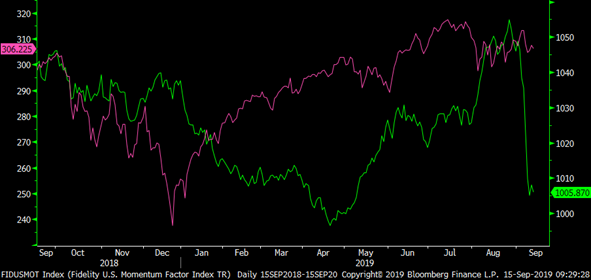...in fixed income markets was kind of noteworthy given a number of crowded trades; but it was far more dramatic for equity market quant-strategies. “Factor” or “Smart Beta” algorithm strategies saw two of their popular groups - Momentum and Value - both mean-revert by a combined 10% in a single day as similarly crowded trades got squeezed. For context, that’s a 5-standard deviation event...or more tangibly, just picture the media headlines if the S&P had fallen 10% in one day last week.
Dramatic as it was, the impact was really only felt by certain quant-based hedge funds and ETFs. However, it brought with reminiscences of 2007’s “Quant Quake”, a similar behind-the-scenes event that occurred just as the S&P peaked leading into the Financial Crisis. With current economic data decelerating the parallels are obvious. But the subsequently narrative that this event marks a multi-year return of Value as a winning strategy after 12 years of underperforming Momentum/Growth seems either premature or misguided. For example, a significant part of this week’s events had to do with shorts getting squeezed...hardly the hardly the basis for a paradigm shift.
Pure Momentum Indexes: Fidelity (long-only, pink) vs. Bloomberg (long/short, green) – one year returns

Source: Bloomberg
A far more important action & reaction - in our opinion - was that incoming global economic data continued flashing yellow-to-red warning signals (action), which was met by the first sign of a crack in the Trump administration’s trade stance (reaction). Major central banks also continued to ease monetary policy, with the ECB pushing rates further negative and resuming QE.
US GDP resilience since the trade war emerged has been mainly a story of a contracting manufacturing sector offset by booming US consumer spending. US employment data last Friday showed only 130k new jobs created last month, 40% below last year’s monthly average of 225k. Slowing employment numbers are a direct threat to consumer spending; so reports this week that the White House is now considering a temporary deal with China to fully roll back certain tariffs is a welcome surprise. It is likely not coincidental that the trade war is no longer polling well in some key States.
A sharp de-escalation of trade friction together with the Fed’s continued easing may just be a big and fast enough response to avert an outright recession. Further progress on both – starting with a rate cut and clear guidance towards more at this Wednesday’s Fed meeting – will be key, particularly as we head towards what is likely to be an underwhelming earnings season in 4-6 weeks.
